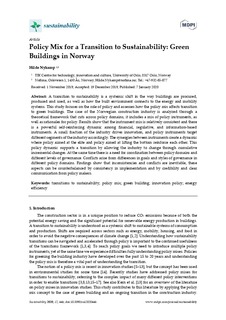| dc.contributor.author | Nykamp, Hilde | |
| dc.date.accessioned | 2020-01-14T08:51:21Z | |
| dc.date.available | 2020-01-14T08:51:21Z | |
| dc.date.created | 2020-01-09T09:25:55Z | |
| dc.date.issued | 2020 | |
| dc.identifier.citation | Sustainability. 2020, 12 (2), . | |
| dc.identifier.issn | 2071-1050 | |
| dc.identifier.uri | http://hdl.handle.net/11250/2636088 | |
| dc.description.abstract | A transition to sustainability is a systemic shift in the way buildings are procured, produced and used, as well as how the built environment connects to the energy and mobility systems. This study focuses on the role of policy and assesses how the policy mix affects transition to green buildings. The case of the Norwegian construction industry is analyzed through a theoretical framework that cuts across policy domains, it includes a mix of policy instruments, as well as rationales for policy. Results show that the instrument mix is relatively consistent and there is a powerful self-reinforcing dynamic among financial, regulative, and information-based instruments. A small fraction of the industry drives innovation, and policy instruments target different segments of the industry accordingly. The synergies between instruments create a dynamic where policy aimed at the elite and policy aimed at lifting the bottom reinforce each other. This policy dynamic supports a transition by allowing the industry to change through cumulative incremental changes. At the same time there is a need for coordination between policy domains and different levels of governance. Conflicts arise from differences in goals and styles of governance in different policy domains. Findings show that inconsistencies and conflicts are inevitable, these aspects can be counterbalanced by consistency in implementation and by credibility and clear communication from policy makers. | |
| dc.language.iso | eng | |
| dc.title | Policy Mix for a Transition to Sustainability: Green Buildings in Norway | |
| dc.type | Peer reviewed | |
| dc.type | Journal article | |
| dc.description.version | publishedVersion | |
| dc.source.pagenumber | 12 | |
| dc.source.volume | 12 | |
| dc.source.journal | Sustainability | |
| dc.source.issue | 2 | |
| dc.identifier.doi | 10.3390/su12020446 | |
| dc.identifier.cristin | 1768987 | |
| dc.relation.project | Nofima AS: 201703 | |
| dc.relation.project | Norges forskningsråd: 262303 | |
| cristin.unitcode | 7543,3,3,0 | |
| cristin.unitname | Sensorikk, forbruker og innovasjon | |
| cristin.ispublished | true | |
| cristin.fulltext | original | |
| cristin.qualitycode | 1 | |
